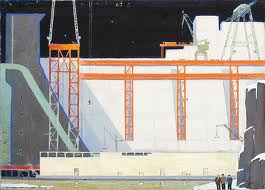 The current exhibit at The Museum of Russian Art (TMORA) is a pleasure for the senses but a challenge for the intellect. “From Thaw to Meltdown: Soviet Paintings of the 1950s-1980s” presents a narrow view of Soviet art, focusing on the theme of industrialization in paintings during the post-Stalin era. This thematic restriction might give the impression that artistic subject matter in the USSR was severely limited during this time period, but this is not the case, as even a cursory look at the lyrical landscapes, genre scenes and floral still lifes of artists not represented in the exhibit, such as Irina Baldina, Eugenia Antipova and Tatiana Kopnina, demonstrate.
The current exhibit at The Museum of Russian Art (TMORA) is a pleasure for the senses but a challenge for the intellect. “From Thaw to Meltdown: Soviet Paintings of the 1950s-1980s” presents a narrow view of Soviet art, focusing on the theme of industrialization in paintings during the post-Stalin era. This thematic restriction might give the impression that artistic subject matter in the USSR was severely limited during this time period, but this is not the case, as even a cursory look at the lyrical landscapes, genre scenes and floral still lifes of artists not represented in the exhibit, such as Irina Baldina, Eugenia Antipova and Tatiana Kopnina, demonstrate.
Some of the best paintings in the current exhibit come from the 1960s. Tamaz Ambakovich Dzhincharadze’s “A Miner” (1962) is a powerful image of exhaustion executed in bold brushstrokes and subdued tones. In this painting, there is no glorification of the working man, but an intimate, yet unsentimental view of a human being resting after a hard day’s work. The image provokes a quiet respect, rather than pity, for these workers.
Yuri Ivanovich Bosko’s “A Woman of the Volga” (1967) uses a high-keyed palette to present a view of Russian women as independent, hard-working and content with their role as working women. The Volga River, ubiquitous in Russian painting, is not a mere backdrop to the figure, as it holds symbolic significance in Russia as “Mother,” emphasizing the esteem for working women in the Soviet state.
There is still very little exposure to and knowledge of Soviet art among Western audiences, given the isolation of that country after the 1917 revolution and the later tangle of propaganda and fact during the Cold War. This places an educational burden on museums to present these works in context, which, unfortunately, was done poorly in the present case. The curator’s wall placards do little to contextualize or clarify “Socialist Realism,” whose origins predate the revolution and Stalin. It might be better to either ignore the placards and enjoy the paintings, or, if you prefer to understand the historical context of art works, brush up on your Russian history before seeing this exhibit.
The exhibit will run through August 12, 2012. Photos are not allowed. For a preview of the show and more information, go to:
